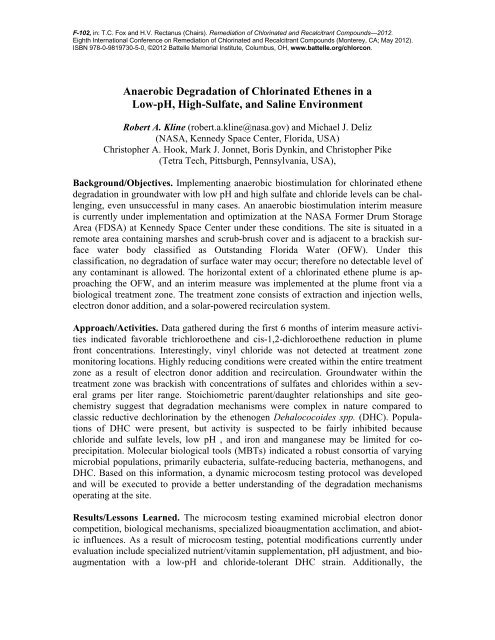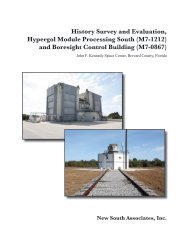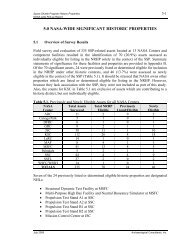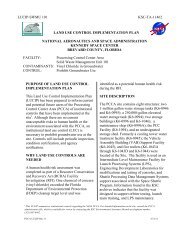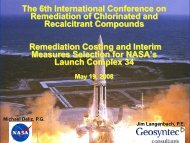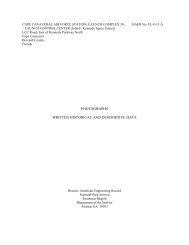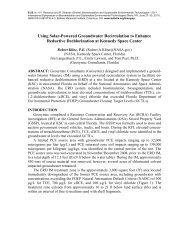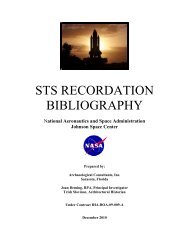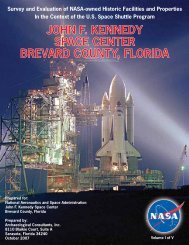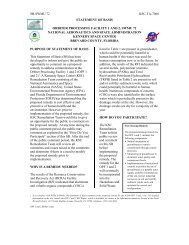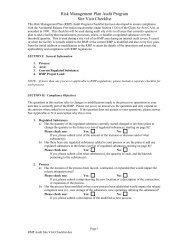Anaerobic Degradation of Chlorinated Ethenes in a Low-pH, High ...
Anaerobic Degradation of Chlorinated Ethenes in a Low-pH, High ...
Anaerobic Degradation of Chlorinated Ethenes in a Low-pH, High ...
You also want an ePaper? Increase the reach of your titles
YUMPU automatically turns print PDFs into web optimized ePapers that Google loves.
F-102, <strong>in</strong>: T.C. Fox and H.V. Rectanus (Chairs). Remediation <strong>of</strong> <strong>Chlor<strong>in</strong>ated</strong> and Recalcitrant Compounds—2012.<br />
Eighth International Conference on Remediation <strong>of</strong> <strong>Chlor<strong>in</strong>ated</strong> and Recalcitrant Compounds (Monterey, CA; May 2012).<br />
ISBN 978-0-9819730-5-0, ©2012 Battelle Memorial Institute, Columbus, OH, www.battelle.org/chlorcon.<br />
<strong>Anaerobic</strong> <strong>Degradation</strong> <strong>of</strong> <strong>Chlor<strong>in</strong>ated</strong> <strong>Ethenes</strong> <strong>in</strong> a<br />
<strong>Low</strong>-<strong>pH</strong>, <strong>High</strong>-Sulfate, and Sal<strong>in</strong>e Environment<br />
Robert A. Kl<strong>in</strong>e (robert.a.kl<strong>in</strong>e@nasa.gov) and Michael J. Deliz<br />
(NASA, Kennedy Space Center, Florida, USA)<br />
Christopher A. Hook, Mark J. Jonnet, Boris Dynk<strong>in</strong>, and Christopher Pike<br />
(Tetra Tech, Pittsburgh, Pennsylvania, USA),<br />
Background/Objectives. Implement<strong>in</strong>g anaerobic biostimulation for chlor<strong>in</strong>ated ethene<br />
degradation <strong>in</strong> groundwater with low <strong>pH</strong> and high sulfate and chloride levels can be challeng<strong>in</strong>g,<br />
even unsuccessful <strong>in</strong> many cases. An anaerobic biostimulation <strong>in</strong>terim measure<br />
is currently under implementation and optimization at the NASA Former Drum Storage<br />
Area (FDSA) at Kennedy Space Center under these conditions. The site is situated <strong>in</strong> a<br />
remote area conta<strong>in</strong><strong>in</strong>g marshes and scrub-brush cover and is adjacent to a brackish surface<br />
water body classified as Outstand<strong>in</strong>g Florida Water (OFW). Under this<br />
classification, no degradation <strong>of</strong> surface water may occur; therefore no detectable level <strong>of</strong><br />
any contam<strong>in</strong>ant is allowed. The horizontal extent <strong>of</strong> a chlor<strong>in</strong>ated ethene plume is approach<strong>in</strong>g<br />
the OFW, and an <strong>in</strong>terim measure was implemented at the plume front via a<br />
biological treatment zone. The treatment zone consists <strong>of</strong> extraction and <strong>in</strong>jection wells,<br />
electron donor addition, and a solar-powered recirculation system.<br />
Approach/Activities. Data gathered dur<strong>in</strong>g the first 6 months <strong>of</strong> <strong>in</strong>terim measure activities<br />
<strong>in</strong>dicated favorable trichloroethene and cis-1,2-dichloroethene reduction <strong>in</strong> plume<br />
front concentrations. Interest<strong>in</strong>gly, v<strong>in</strong>yl chloride was not detected at treatment zone<br />
monitor<strong>in</strong>g locations. <strong>High</strong>ly reduc<strong>in</strong>g conditions were created with<strong>in</strong> the entire treatment<br />
zone as a result <strong>of</strong> electron donor addition and recirculation. Groundwater with<strong>in</strong> the<br />
treatment zone was brackish with concentrations <strong>of</strong> sulfates and chlorides with<strong>in</strong> a several<br />
grams per liter range. Stoichiometric parent/daughter relationships and site geochemistry<br />
suggest that degradation mechanisms were complex <strong>in</strong> nature compared to<br />
classic reductive dechlor<strong>in</strong>ation by the ethenogen Dehalococoides spp. (DHC). Populations<br />
<strong>of</strong> DHC were present, but activity is suspected to be fairly <strong>in</strong>hibited because<br />
chloride and sulfate levels, low <strong>pH</strong> , and iron and manganese may be limited for coprecipitation.<br />
Molecular biological tools (MBTs) <strong>in</strong>dicated a robust consortia <strong>of</strong> vary<strong>in</strong>g<br />
microbial populations, primarily eubacteria, sulfate-reduc<strong>in</strong>g bacteria, methanogens, and<br />
DHC. Based on this <strong>in</strong>formation, a dynamic microcosm test<strong>in</strong>g protocol was developed<br />
and will be executed to provide a better understand<strong>in</strong>g <strong>of</strong> the degradation mechanisms<br />
operat<strong>in</strong>g at the site.<br />
Results/Lessons Learned. The microcosm test<strong>in</strong>g exam<strong>in</strong>ed microbial electron donor<br />
competition, biological mechanisms, specialized bioaugmentation acclimation, and abiotic<br />
<strong>in</strong>fluences. As a result <strong>of</strong> microcosm test<strong>in</strong>g, potential modifications currently under<br />
evaluation <strong>in</strong>clude specialized nutrient/vitam<strong>in</strong> supplementation, <strong>pH</strong> adjustment, and bioaugmentation<br />
with a low-<strong>pH</strong> and chloride-tolerant DHC stra<strong>in</strong>. Additionally, the
feasibility <strong>of</strong> cultur<strong>in</strong>g <strong>in</strong>digenous microbial populations acclimated to the site’s geochemical<br />
conditions is be<strong>in</strong>g considered.
<strong>Anaerobic</strong> <strong>Degradation</strong> <strong>of</strong> <strong>Chlor<strong>in</strong>ated</strong> <strong>Ethenes</strong> <strong>in</strong> a<br />
<strong>Low</strong>-<strong>pH</strong>, <strong>High</strong>-Sulfate, and Sal<strong>in</strong>e Environment<br />
FDSA<br />
NASA, Kennedy Space Center – Michael J. Deliz, PG, Robert A. Kl<strong>in</strong>e, PE<br />
Tetra Tech - Chris 1 Hook, PE, Mark Jonnet, Boris Dynk<strong>in</strong>, PE, Chris Pike, PE
Objectives<br />
•Site overview<br />
•IM pilot study summary<br />
• Design<br />
• Geochemical data<br />
• Biological data<br />
• Pilot study modifications<br />
• Contam<strong>in</strong>ant data<br />
•Path forward<br />
2
Site Location<br />
FDSA<br />
3
Pilot Study Introduction<br />
•ISB Pilot Study at Outstand<strong>in</strong>g Florida Water (OFW) Area<br />
•CMS prescribed remedy – DPT ISB<br />
•Basis for future treatments<br />
•Supplemental <strong>in</strong>vestigation<br />
fidelity resulted <strong>in</strong> changed<br />
site conditions<br />
•Acceptable basel<strong>in</strong>e biological<br />
and geochemical conditions<br />
• <strong>Low</strong> sulfate/sulfide<br />
• <strong>Low</strong> chloride<br />
• Neutral <strong>pH</strong><br />
4
Pilot Study Objectives<br />
•Prevent discharge <strong>of</strong> CVOCs to OFW<br />
•Create a zone <strong>of</strong> groundwater treatment as plume<br />
approaches OFW<br />
•Collect data to determ<strong>in</strong>e the technology effectiveness<br />
•Ma<strong>in</strong>ta<strong>in</strong> cont<strong>in</strong>uous recirculation utiliz<strong>in</strong>g solar power<br />
•Develop basis for expansion upgradient<br />
5
Pilot Study Design<br />
• 3 recovery wells (3 gpm/well)<br />
• 8 Injection wells (~1 gpm/well)<br />
• Treatment zone:<br />
• ~150’ wide by ~100’ long by ~25’ deep<br />
• ~54 day pore volume exchange time<br />
• 24-hours operation via solar power<br />
• Designed to allow use <strong>of</strong> different<br />
substrates and amendments<br />
• Flexible manifold for active plume<br />
management<br />
• Monitor<strong>in</strong>g zones:<br />
• Shallow (5 – 15 feet bls)<br />
• Intermediate (15 to 25 feet bls)<br />
FDSA<br />
6
Pilot Study Equipment<br />
•Use<br />
System Trailer (view from South)<br />
System Trailer (view from North East)<br />
FDSA<br />
Substrate & Meter<strong>in</strong>g Pumps<br />
System Stub-outs (view from West)<br />
Manifolds & Meter<strong>in</strong>g Pumps<br />
7
Pilot Study Injection/Extraction Layout<br />
•Use<br />
Extraction Well (RW03)<br />
8<br />
Injection Well Transect
Pilot Study Data - Chloride<br />
18<br />
Chloride - Shallow Wells<br />
Near Injection Transect (MW08S) Center Treatment Cell (MW25S)<br />
Center Treatment Cell (MW27S)<br />
Downgradient (MW22S)<br />
18<br />
Chloride - Intermediate Wells<br />
Near Injection Transect (MW08I) Center Treatment Cell (MW26I)<br />
Center Treatment Cell (MW28I)<br />
Downgradient (MW24I)<br />
16<br />
16<br />
14<br />
14<br />
12<br />
12<br />
Concentration (g/L)<br />
10<br />
8<br />
6<br />
Concentration (g/L)<br />
10<br />
8<br />
6<br />
4<br />
4<br />
2<br />
2<br />
0<br />
10/10/2010 4/8/2011 10/5/2011 4/2/2012<br />
0<br />
10/10/2010 4/8/2011 10/5/2011 4/2/2012<br />
9
Pilot Study Data - Sulfate<br />
2.5<br />
Sulfate - Shallow Wells<br />
Near Injection Transect (MW08S) Center Treatment Cell (MW25S)<br />
Center Treatment Cell (MW27S)<br />
Downgradient (MW22S)<br />
2.5<br />
Sulfate - Intermediate Wells<br />
Near Injection Transect (MW08I) Center Treatment Cell (MW26I)<br />
Center Treatment Cell (MW28I)<br />
Downgradient (MW24I)<br />
2<br />
2<br />
Concentration (g/L)<br />
1.5<br />
1<br />
Concentrato<strong>in</strong> (g/L)<br />
1.5<br />
1<br />
0.5<br />
0.5<br />
0<br />
10/10/2010 4/8/2011 10/5/2011 4/2/2012<br />
0<br />
10/10/2010 4/8/2011 10/5/2011 4/2/2012<br />
10<br />
*Sulfide historically ranges from 40-100 mg/L (magnitudes
Pilot Study Data – <strong>pH</strong><br />
<strong>pH</strong> - Shallow Wells<br />
<strong>pH</strong> - Intermediate Wells<br />
7.5<br />
7.0<br />
Near Injection Transect (MW08S)<br />
Center Treatment Cell (MW25S)<br />
Center Treatment Cell (MW27S)<br />
Downgradient (MW22S)<br />
<strong>pH</strong> buffer<strong>in</strong>g<br />
pilot<br />
7.5<br />
7.0<br />
Near Injection Transect (MW08I)<br />
Center Treatment Cell (MW26I)<br />
Center Treatment Cell (MW28I)<br />
6.5<br />
6.5<br />
<strong>pH</strong> (SU)<br />
6.0<br />
<strong>pH</strong> (SU)<br />
6.0<br />
5.5<br />
5.0<br />
5.5<br />
5.0<br />
<strong>pH</strong> buffer<strong>in</strong>g<br />
pilot<br />
4.5<br />
09/19/10 03/18/11 09/14/11 03/12/12<br />
4.5<br />
09/19/10 03/18/11 09/14/11 03/12/12<br />
11
Passive Buffer Test<strong>in</strong>g<br />
12
Additional Geochemical/Dissolved Gas Data<br />
• ORP – – 200 to – 300 mV<br />
• TOC – 20 mg/L (near <strong>in</strong>jection) gradient down to 5 mg/L (near<br />
extraction)<br />
• Alkal<strong>in</strong>ity – 350 mg/L (site average)<br />
• Acidity – 120 mg/L (site average)<br />
• Dissolved iron (total) – 30 mg/L (site average)<br />
• Ferrous/ferric iron speciation variable spatially<br />
• Dissolved Gases<br />
• Methane – 530 mg/L (site average)<br />
• Ethane – Generally ND<br />
• Ethene – <strong>Low</strong>/negligible detections<br />
• Carbon Dioxide – Initially 3 mg/L; now 234 mg/L (average)<br />
13
Microcosm Analysis<br />
6.0<br />
4.0<br />
µM<br />
2.0<br />
Test #1: Killed control<br />
DCE<br />
TCE<br />
6.0<br />
4.0<br />
µM<br />
2.0<br />
Test #2: Lactoil & m<strong>in</strong>eral amended, B12, <strong>pH</strong> 7,<br />
<strong>in</strong>digenous population<br />
ppm<br />
SO4<br />
TCE<br />
DCE<br />
2000 6.0<br />
1600<br />
4.0<br />
1200<br />
ppm µM<br />
SO4<br />
800<br />
2.0<br />
400<br />
Test #3. Lactoil & m<strong>in</strong>eral amended B12, <strong>pH</strong> 7<br />
Bioaug days w/<strong>High</strong> Salt Culture<br />
bio<br />
aug<br />
day 19<br />
|<br />
ppm<br />
SO4<br />
TCE<br />
|<br />
bio<br />
aug<br />
day 56<br />
|<br />
DCE<br />
VC<br />
2000<br />
1600<br />
1200<br />
ppm<br />
SO4<br />
800<br />
400<br />
0.0<br />
VC<br />
0 20 40 days 60 80 100<br />
0.0<br />
VC<br />
FDSA<br />
0 20 40 days 60 80 100<br />
0<br />
0.0<br />
Ethene<br />
0 20 40 days 60 80 100<br />
0<br />
6.0<br />
4.0<br />
µM<br />
2.0<br />
ppm SO4<br />
DCE<br />
Test #4. Lactoil & m<strong>in</strong>eral amended<br />
Accelerite, <strong>pH</strong> 6.1, <strong>in</strong>digenous population<br />
TCE<br />
2000 6.0<br />
1600<br />
4.0<br />
1200<br />
µM<br />
ppm<br />
SO4<br />
800<br />
2.0<br />
400<br />
DCE<br />
Test #5. Lactoil & m<strong>in</strong>eral amended B12, <strong>pH</strong> 6.1.<br />
low <strong>pH</strong> culture & high salt culture<br />
bioaug<br />
day 19<br />
|<br />
ppm<br />
SO4<br />
TCE<br />
bioaug<br />
day 56<br />
|<br />
2000<br />
1600<br />
1200<br />
ppm<br />
SO4<br />
800<br />
400<br />
0.0<br />
14<br />
VC<br />
0 20 40 days 60 80 100<br />
0<br />
0.0<br />
VC<br />
0 20 40 days 60 80 100<br />
0
Biological Activity<br />
• Complex mechanisms (e.g., cometabolism/beta-elim<strong>in</strong>ations/etc.)<br />
• CaCO 3 addition affected microbial activity (Feb 2012)<br />
• Geochemical shifts from buffer<strong>in</strong>g affected IRB/SRB activity<br />
• Reduced competition from preferential sulfate reduction<br />
• TCEr detected for the first time after buffer<strong>in</strong>g (substrate “peck<strong>in</strong>g order”)<br />
• VCr/BVC historically nondetect<br />
• Sharp TCE concentration reductions; VC consistently detected for first time<br />
FDSA<br />
Buffer Test<br />
Buffer Test<br />
15
Concentration Data<br />
FDSA<br />
16
MW25S MOLAR CONCENTRATIONS<br />
20<br />
Concentration TCE cDCE Data<br />
VC<br />
Molar Concentration (µmol/L)<br />
16<br />
12<br />
8<br />
4<br />
0<br />
10/10/2010 4/8/2011 10/5/2011 4/2/2012<br />
Molar Concentration (µmol/L)<br />
10<br />
8<br />
6<br />
4<br />
2<br />
MW26I MOLAR CONCENTRATIONS<br />
TCE cDCE VC<br />
0<br />
10/10/2010 4/8/2011 10/5/2011 4/2/2012<br />
FDSA<br />
Molar Concentration (µmol/L)<br />
20<br />
16<br />
12<br />
8<br />
4<br />
MW14S MOLAR CONCENTRATIONS<br />
TCE cDCE VC<br />
0<br />
10/10/2010 4/8/2011 10/5/2011 4/2/2012<br />
17<br />
Molar Concentration (µmol/L)<br />
6<br />
5<br />
4<br />
3<br />
2<br />
1<br />
MW28I MOLAR CONCENTRATIONS<br />
TCE cDCE VC<br />
0<br />
10/10/2010 4/8/2011 10/5/2011 4/2/2012<br />
Molar Concentration (µmol/L)<br />
6<br />
5<br />
4<br />
3<br />
2<br />
1<br />
MW27S MOLAR CONCENTRATIONS<br />
TCE cDCE VC<br />
0<br />
10/10/2010 4/8/2011 10/5/2011 4/2/2012
Path Forward<br />
•Cont<strong>in</strong>ue to evaluate <strong>in</strong>fluence <strong>of</strong> CaCO 3 buffer<strong>in</strong>g<br />
• Consider <strong>in</strong>tegration <strong>in</strong>to pilot study/IM<br />
•Cont<strong>in</strong>ue to monitor biological and geochemical<br />
parameters<br />
• Development <strong>of</strong> TCEr and VCr/BVC functional genes<br />
• Sulfate reduction and SRB activity<br />
•Monitor degradation performance<br />
•If functional genes not present, evaluate augmentation<br />
with chloride-tolerant culture from microcosm<br />
•Pend<strong>in</strong>g additional data, expand upgradient as an IM<br />
18
Acknowledgements<br />
•NASA, Kennedy Space Center (site management lead)<br />
•Tetra Tech (site assessment, CMS, pilot test<strong>in</strong>g)<br />
•BCI Laboratories (Microcosm Test<strong>in</strong>g, Data Evaluation)<br />
•Microbial Insights (CENSUS Analysis)<br />
•JRW Remediation (Pilot Test<strong>in</strong>g Support, Data<br />
Evaluation)<br />
19


